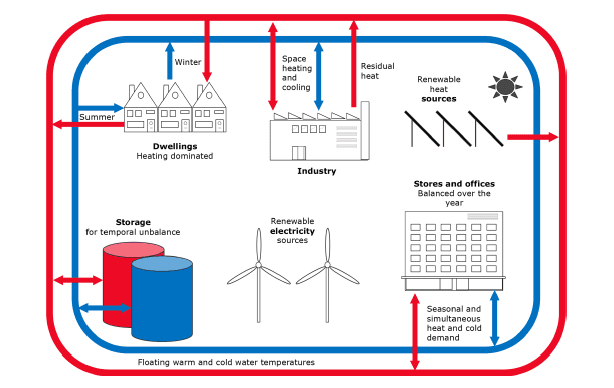What is district heating and why is it gaining popularity?

What is district heating?
As the name suggests, district heating refers to the heating of a district or a collective of buildings or residences from a single central hub. This approach is often praised for having higher efficiency and improved pollution control compared to the alternative of using many localised boilers.
Examples of district heating can be traced back a far as the Romans who created Hypocausts as a method to disperse the heat from a furnace across nearby buildings and hot baths. Although the usage was limited at the time due to the high cost, evidence of their usage has been found across Europe, northern Africa and western Asia. Modern district heating could not be more different to the methods used in the past; however, it’s still built on the same premise – that a central source of heat can be used to provide for more than one building.
Whilst these Roman hypocausts used primarily wood and charcoal, the modern approaches to district heating are increasingly varied in both their fuel intake and their applications. Most effective in systems that have a constant requirement for energy around the clock, district heating is often installed in universities, ports or hospitals to save on costs. Their application can also extend to residences within community networks and it’s this diversity of uses that has contributed to the increased uptake.
Changing energy sources
Beyond the savings gained from the improved efficiency – district heating is also benefitting from the uptake of more varied energy sources. With the ability to combine the energy from multiple sources, this can then be used to provide the heating and cooling for the community from a central hub. To date, district heating has been almost entirely powered by fossil fuels, with only around 8% of the energy coming from renewables in 2018. Despite this, the option to slowly increase the renewable input into these systems makes them a viable heating solution as we move towards a more carbon conscious society. In many aspects, this makes the technology more future-proof than alternatives and therefore makes it an appealing investment for governments.
Successful uptake
Countries such as Iceland and Denmark have achieved great success with their district heating projects and it’s expected that more of the world will follow their example in the future. Since the first installation in 1930, Iceland has been developing this system with an increasing emphasis on using the natural geothermal energy that they have in abundance. This has been extremely successful and now they can boast 61 district heating systems that serve more than 90% of the population with heating that is also 90% renewable – the exceptions being rural areas and individual homes that aren’t compatible with district heating due to their size or their isolation.
UK and Europe
In the UK, and Europe as a whole, installations have increased greatly in the last decade as more emphasis is being placed on creating low-emission alternatives. An example of this is the Heat Networks Investment Project that offers funding to local authorities to increase their district heating capacity. Due to the savings in cost and emissions, the goal of this is to produce between 15 and 18% of the nation’s heating from networks like this by 2050.
For these reasons, it seems inevitable that district heating will become more commonplace in the next decades. Offering increased efficiency with energy production which in leads to reduced carbon emissions, it provides an attractive alternative to conventional heating. As research into this field continues, these benefits will only continue to increase. Denmark is already upgrading their network to 4th generation district heating plants whilst research and development of 5th generation projects is already being looked into by many nations.
If you’re looking to find out more about renewable heating systems from Warmaway, we offer expert recommendations on the suitability of each of the options for your home. Get in touch to find out more.


